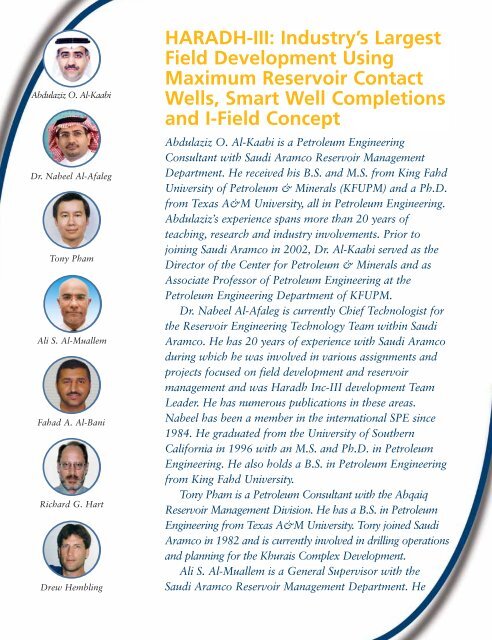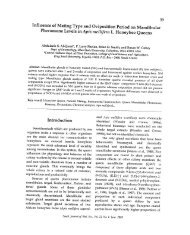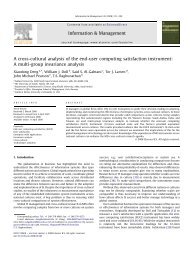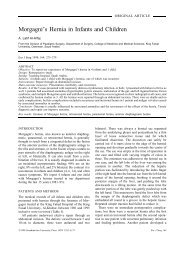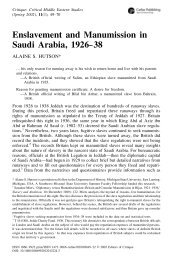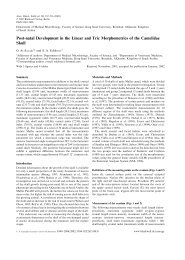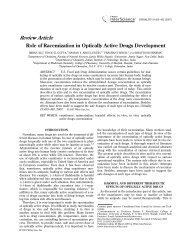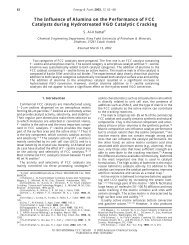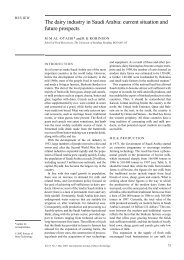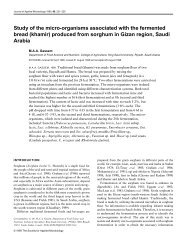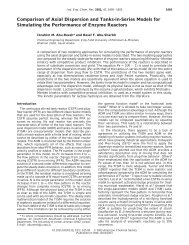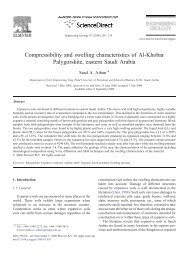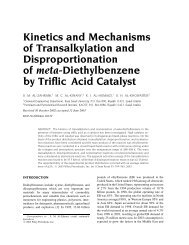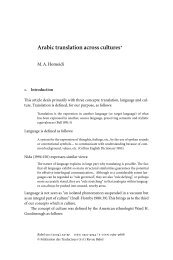HARADH-III: Industry's Largest Field Development Using Maximum ...
HARADH-III: Industry's Largest Field Development Using Maximum ...
HARADH-III: Industry's Largest Field Development Using Maximum ...
Create successful ePaper yourself
Turn your PDF publications into a flip-book with our unique Google optimized e-Paper software.
Abdulaziz O. Al-Kaabi<br />
Dr. Nabeel Al-Afaleg<br />
Tony Pham<br />
Ali S. Al-Muallem<br />
Fahad A. Al-Bani<br />
Richard G. Hart<br />
Drew Hembling<br />
<strong>HARADH</strong>-<strong>III</strong>: Industry’s <strong>Largest</strong><br />
<strong>Field</strong> <strong>Development</strong> <strong>Using</strong><br />
<strong>Maximum</strong> Reservoir Contact<br />
Wells, Smart Well Completions<br />
and I-<strong>Field</strong> Concept<br />
Abdulaziz O. Al-Kaabi is a Petroleum Engineering<br />
Consultant with Saudi Aramco Reservoir Management<br />
Department. He received his B.S. and M.S. from King Fahd<br />
University of Petroleum & Minerals (KFUPM) and a Ph.D.<br />
from Texas A&M University, all in Petroleum Engineering.<br />
Abdulaziz’s experience spans more than 20 years of<br />
teaching, research and industry involvements. Prior to<br />
joining Saudi Aramco in 2002, Dr. Al-Kaabi served as the<br />
Director of the Center for Petroleum & Minerals and as<br />
Associate Professor of Petroleum Engineering at the<br />
Petroleum Engineering Department of KFUPM.<br />
Dr. Nabeel Al-Afaleg is currently Chief Technologist for<br />
the Reservoir Engineering Technology Team within Saudi<br />
Aramco. He has 20 years of experience with Saudi Aramco<br />
during which he was involved in various assignments and<br />
projects focused on field development and reservoir<br />
management and was Haradh Inc-<strong>III</strong> development Team<br />
Leader. He has numerous publications in these areas.<br />
Nabeel has been a member in the international SPE since<br />
1984. He graduated from the University of Southern<br />
California in 1996 with an M.S. and Ph.D. in Petroleum<br />
Engineering. He also holds a B.S. in Petroleum Engineering<br />
from King Fahd University.<br />
Tony Pham is a Petroleum Consultant with the Abqaiq<br />
Reservoir Management Division. He has a B.S. in Petroleum<br />
Engineering from Texas A&M University. Tony joined Saudi<br />
Aramco in 1982 and is currently involved in drilling operations<br />
and planning for the Khurais Complex <strong>Development</strong>.<br />
Ali S. Al-Muallem is a General Supervisor with the<br />
Saudi Aramco Reservoir Management Department. He
eceived his B.S. in Petroleum Engineering from King Fahd<br />
University of Petroleum & Minerals (KFUPM). His<br />
experience includes 19 years with Saudi Aramco, where he<br />
worked in several departments including Production<br />
Engineering, Reservoir Simulation and Reservoir<br />
Management. Ali is currently responsible for the reservoir<br />
management of the giant Ghawar field and was directly<br />
involved with the latest two increment developments in the<br />
Haradh area.<br />
Fahad A. Al-Bani is a Supervisor in the Drilling<br />
Engineering Department, <strong>Development</strong> Drilling Engineering<br />
Division. Fahad graduated with a B.S. in Petroleum<br />
Engineering from King Saud University and joined Saudi<br />
Aramco in 1996 as Drilling Engineer. He has been a<br />
member of SPE since 1998.<br />
Richard G. Hart is an Operations/<strong>Field</strong> Geologist for the<br />
Southern <strong>Field</strong>s Characterization Division currently<br />
assigned to the Khurais Complex <strong>Development</strong> Team. He<br />
received his B.S. in Geoscience from Purdue University and<br />
a M.A. in Geology from the University of Missouri. Rick<br />
worked as a <strong>Development</strong> Geologist for Marathon Oil<br />
Company for 22 years and joined Saudi Aramco in 2001.<br />
Drew Hembling is a Completion Team Leader working<br />
in the Petroleum Engineering Support Division of Saudi<br />
Aramco’s Producing Facilities <strong>Development</strong> Department.<br />
He graduated from West Virginia University with a B.S. in<br />
Petroleum Engineering in 1983. Drew worked for Conoco<br />
Inc. from 1983 to 1997, and ARCO in Anchorage from<br />
1997 to 2000. He joined Saudi Aramco in 2000 as a<br />
Completion Specialist.<br />
ABSTRACT<br />
The development of Haradh-<strong>III</strong> in the southernmost area of<br />
Ghawar represents a major shift in paradigm in terms of the<br />
combination of the technologies. The field development<br />
combines four main technology features which include<br />
maximum reservoir contact (MRC) wells, smart<br />
completions, extensive use of real-time geosteering and I-<br />
<strong>Field</strong> initiatives.<br />
This paper describes the motivation, implementation, and<br />
post-production evaluation of this unique field<br />
development. In the case of Haradh-<strong>III</strong>, field development<br />
with smart MRC wells delays water encroachment,<br />
improves flood front conformance and recovery, lowers<br />
water production and long term development and operating<br />
costs. Bottom water encroachment into the wellbore is<br />
mitigated as downhole Internal Control Valves (ICV), as<br />
part of the smart completion, are adjusted. This in turn<br />
lengthens the life of the well, allows sweep and recovery to<br />
take place in the reservoir below the horizontal wellbores<br />
48 SAUDI ARAMCO JOURNAL OF TECHNOLOGY SUMMER 2007<br />
through the most effective sweep process: the replacement<br />
mechanism by gravity. The objectives of the development<br />
are accomplished utilizing a reduced number of wells,<br />
minimizing the accompanying infrastructure, therefore<br />
lowering the capital expenditure while reducing the<br />
operating cost by maintaining, on a long-term basis, a lowwater<br />
producing system, all occurring in real time and<br />
within the I-<strong>Field</strong> environment.<br />
INTRODUCTION<br />
Production from Haradh-<strong>III</strong> development started in<br />
February 2006. The project included a combination of<br />
MRC wells, smart completions, geosteering, and I-<strong>Field</strong><br />
concept which provides real time access to downhole<br />
information. The efficient integration along with<br />
understanding of the fluid flow mechanisms in the reservoir<br />
was the key to the success of the project.<br />
Haradh field locates at the southernmost portion of the<br />
Ghawar complex and covers an area 75 km long and is 26<br />
km at its widest section (Fig. 1). The field consists of three<br />
sub-segments of approximately equivalent reserves, with an<br />
aggregate Oil Initially In Place in the order of tens of<br />
billions of barrels. Initial production from Haradh-I started<br />
in May 1996, followed by Haradh-II and Haradh-<strong>III</strong> in<br />
April 2003 and February 2006, respectively. The field<br />
developments, occurring over a span of a decade, offer a<br />
unique opportunity in gauging the impact of technologies.<br />
Haradh-I was developed exclusively by utilizing vertical<br />
wells, whereas horizontal completions provided the primary<br />
configuration for producers/injectors in Haradh-II. Haradh-<br />
<strong>III</strong>, the main focus of this paper, was developed by relying<br />
mainly on smart MRC completions (Fig. 2) within an I-<br />
Fig. 1. 3D map showing Haradh field and its three main subdivisions.<br />
Schematic (right) shows Ghawar complex.
Fig. 2. Schematic map showing Haradh-<strong>III</strong> initial development plan utilizing<br />
MRC wells 1 .<br />
<strong>Field</strong> framework. The total Haradh production capacity is<br />
900 MBD, with equal contributions from the three<br />
respective sub-segments I, II and <strong>III</strong> with key statistics for<br />
Haradh-<strong>III</strong> as shown in Table-1 1 .<br />
GEOLOGICAL SETTING<br />
Geologically, the Arab-D carbonate reservoir is divided into<br />
several zones: Zone-1, at the top, is a thin layer separated<br />
from the main producing zones by an impermeable<br />
nonporous layer of anhydrite. Zone-2A, below Zone-1, is<br />
mostly skeletal oolitic limestone with scattered vugs and<br />
local super-permeability zones (Super-K). Below Zone-2A is<br />
Production,<br />
MBD<br />
300 MPFM 40<br />
Injection, MBD 560 RTU/SCADA 72<br />
Producers 32 Flowlines (10”) 68 Km<br />
Injectors 28 On-stream Date 2/06<br />
EV/OBS 12 Injection Startup 9/05<br />
PDHMS 40 ICV’s 87<br />
Average PI 150<br />
Average Reservoir<br />
Contact<br />
5 Km<br />
MRC Wells: Combination of Tri-laterals and Quad-Laterals<br />
Legend:<br />
MFPM Multiphase Flow Meter<br />
RTU Remote Testing Unit<br />
ICV Internal Control Valve (Sub-Surface)<br />
PDHMS Permanent Down-hole Monitoring System<br />
EV/OBS Evaluation/Observation Wells<br />
Table 1. Installation Timing Breakdown<br />
Fig. 3. Borehole Image logs showing Super-K interval (left) and vertical<br />
fractures (right). The middle photograph is an analog from Arab-D outcrop<br />
showing vertical fractures intersecting a leached stratiform (Super-K) interval.<br />
Zone-2B, which commonly includes dolomite and<br />
cladocoropsis based Super-K intervals 2 (Fig. 3). Below<br />
Zone-2B are Zones-3A and -3B which have significantly<br />
lower reservoir quality.<br />
Major and minor faults identified from 3D seismic data<br />
and associated fracture swarms (corridors) have been<br />
observed in various degrees throughout the Arab-D<br />
reservoir in adjacent areas 3 . In addition, diffuse fractures<br />
are pervasively observed in cores (Fig. 4). More details on<br />
reservoir characterization are presented next.<br />
Fracture and Super-K Characterization<br />
The fracture network in the Haradh Arab-D reservoir<br />
mainly corresponds to fracture swarms. At wellbore scale,<br />
fracture swarms are observed as moderately dipping<br />
fractures with scattered orientations with the majority of<br />
the orientations parallel to the maximum stress direction. At<br />
reservoir scale, fracture swarms form a series of fracture<br />
corridors that serve as conduits to bring water in-field. This<br />
conclusion is in agreement with the observations from<br />
Arab-D outcrops in central Saudi Arabia (Fig. 3). It is also<br />
supported by dynamic data from well performance.<br />
The stratiform Super-K 4 on the other hand has been<br />
observed as a super-permeability layer with high flow. The<br />
Fig. 4. Photograph of Arab-D core sample showing diffuse fractures.<br />
SAUDI ARAMCO JOURNAL OF TECHNOLOGY SUMMER 2007 49
Fig. 5. Ranking analysis of key reservoir parameters 5 .<br />
prevalence of super-permeability, however, points to a corallike<br />
organism, referred to as cladocoropsis 2, 5 , which was<br />
dolomitized and subsequently leached out leaving pencil-sized<br />
vugs yielding horizontal permeabilities in the Darcy Range.<br />
The fractures and the Super-K, when interconnected on a<br />
field-wide basis, contribute significantly to water<br />
encroachment which tends to reduce productivity of<br />
individual wells. The understanding of how fluids flow in<br />
the reservoir is dominantly affected by these two important<br />
geological features. Defining their effects is vital before any<br />
field development scheme can be formulated and accepted.<br />
This is the subject of the next section.<br />
Understanding Fluid Flow Mechanics in Haradh <strong>Field</strong><br />
The prerequisite for an optimum field development starts<br />
with the understanding of fluid flow mechanisms in the<br />
reservoir. As the main path of fluid flow is controlled by the<br />
high permeability (i.e., stratiform Super-K and fractures) it<br />
is important to define and quantify their impact. <strong>Using</strong><br />
performance of the relatively more mature neighboring area<br />
(Haradh-I) to evaluate the reservoir behavior, different<br />
models (probabilistic models, streamline models and dual<br />
porosity-permeability models) were constructed for this<br />
purpose. Results from such models were then compared<br />
against field observations for validation before final<br />
conclusions were drawn.<br />
PROBABILSTIC MODELS<br />
The identification of Super-K and fractures involves<br />
uncertainty. Thus their impact on cumulative production<br />
and recovery has to be formulated probabilistically.<br />
Tested probabilistic models used random population for<br />
seven different key reservoir parameters including fractures<br />
and Super-K in an experimental design modeling<br />
procedure 3, 6 . Probability analyses ranked reservoir<br />
50 SAUDI ARAMCO JOURNAL OF TECHNOLOGY SUMMER 2007<br />
parameters according to their impact on production and<br />
recovery. Seven parameters were identified in the study.<br />
These include: (1) The connectivity of the fracture network<br />
(Lcon), (2) The aquifer size (Vaq), (3) Super-K<br />
permeabilities (Ksk), (4) Skin factor (Skin), (5) Vertical-tohorizontal<br />
permeability ratio (KZH), (6) Fracture<br />
conductivity of two fracture sets (C1, C2), and (7) Residual<br />
oil saturation (Sorw). Various combinations of parameters<br />
were also studied (e.g., the combination of fracture and<br />
Super-K permeabilities).<br />
The Tornado Chart of Fig. 5 indicates that the three most<br />
controlling parameters (in decreasing order) are: (1) The<br />
connectivity of the fracture network (Lcon), (2) The aquifer<br />
volume (Vaq), and (3) Super-K permeabilities (Ksk).<br />
Based on the above conclusions, we constructed some<br />
phenomenological models to better define the fluid flow<br />
mechanisms in the reservoir.<br />
PHENOMENOLOGICAL MODELS<br />
Two phenomenological models (fine-grid 3D simulation,<br />
and streamline) were constructed in the neighboring<br />
Haradh-I to evaluate which one of the two heterogeneities<br />
(i.e., stratiform Super-K or fractures) is mainly responsible<br />
for the observed early water encroachment.<br />
Several observations were concluded from the fine grid<br />
3D model. It was found that the Super-K layer needs to be<br />
continuous from the injector to the producer to control<br />
early water breakthrough. This implies that the Super-K<br />
layer has to be correlated and interconnected over a vast<br />
(several kilometers) distance. This is not substantiated with<br />
field observation.<br />
The second phenomenological model is the streamline<br />
model. The objective of such a model is to study the role of<br />
fractures in fluid flow and to identify the “responsible<br />
fractures” from all of the faults/fracture lineaments identified<br />
from 3D seismic data. In this case, “responsible fractures”<br />
refer to fractures that are responsible for premature water<br />
breakthrough in the producing area of the reservoir.<br />
For simplicity, the streamline model was set up with<br />
constant pressure boundaries for both producers and<br />
injectors. Aggregated fracture swarms (corridors) tend to<br />
provide better pressure support than those that are in low<br />
fracture density area. The main reason is that fractures tend<br />
to be more interconnected when their density of occurrence<br />
is high. It was observed that water tends to spill<br />
horizontally and outwardly into the matrix as soon as it<br />
reaches the end of the connected fracture network.<br />
Another observation is that conductive fractures<br />
generally oriented in the window of N70E direction and<br />
EW direction. The N70E direction corresponds to the<br />
regional stress field in the Arabian Peninsula while the EW
Fig. 6. Water cut vs. time showing the impact of downhole choke optimization<br />
– Well A-12.<br />
direction corresponds to the localized phenomenon of the<br />
Wadi Sahbah direction 7 .<br />
The streamline model shows that not all fractures are<br />
contributing to water breakthrough in Haradh-I with the<br />
exception of fractures orienting in the N70E and EW<br />
directions. Also, water tends to spill horizontally and<br />
outwardly into the matrix; especially toward the end of the<br />
fractures.<br />
Since the streamline model is time-of-flight based, it is<br />
important to validate the observation with a finite<br />
difference model. For this purpose we constructed a dual<br />
porosity dual permeability (DPDP) sector model which is<br />
summarized next.<br />
DUAL POROSITY DUAL PERMEABILITY<br />
(DPDP) MODEL<br />
Sector DPDP models were constructed to study the<br />
displacement mechanism within the matrix and the<br />
fractures. In the models, fractures and Super-K bodies were<br />
represented by one medium (fracture medium) while matrix<br />
and diffuse fractures were represented by the matrix<br />
medium. Diffuse fractures in the matix medium acted as<br />
vertical permeability enhancers. Complete discussion on the<br />
simulation approach can be found in Ref. 11.<br />
The results from the DPDP models validated the<br />
observation from the streamline model. Where applicable,<br />
water would move quickly in-field through fractures<br />
network and spill out into the matrix. Also, the DPDP<br />
model indicated a water displacement mechanism that is<br />
bottoms-up. The placements of MRC laterals and the<br />
installations of smart completions were field tested to take<br />
advantage of this flow mechanism.<br />
FIELD PILOT<br />
Well A-12<br />
Trilateral MRC well A-12 was drilled through the top of<br />
Zone-2A and completed with hydraulically activated smart<br />
downhole ICV in a high risk (fracture swarms) area. This<br />
was done for the purpose of testing how the downhole ICV<br />
could help optimize the production from various laterals<br />
with respect to water management and oil productivity.<br />
Loss of circulation was encountered in all three laterals.<br />
From the experience in this particular area, loss of<br />
circulation mostly indicates the presence of fractures. Due<br />
to the proximity of the well to the flood front, the well cut<br />
water about two months after it was put on production.<br />
High water production was expected from the well as water<br />
would cone through the fracture into the laterals.<br />
During the tests, rates, water cuts, wellhead samples,<br />
surface and downhole pressure values were collected for<br />
different sets of combinations of downhole valves settings.<br />
It was concluded that water production is choke sensitive<br />
and can be optimized by adjusting downhole ICV. It was<br />
observed that when the motherbore lateral was open at<br />
choke setting 5 (10 is wide open and zero is fully closed),<br />
the well loaded up with water and died. The lower lateral<br />
by itself produced dry oil while the upper lateral is chokesensitive.<br />
At the choke setting of 2, the upper lateral is dry;<br />
on the other hand, the upper lateral produced 65% of<br />
water when it was set at a choke setting of 5.<br />
The well became dead when all downhole chokes were<br />
set at a wide open position while the last test showed that<br />
the well flowed at negligible water cut for more than 10<br />
months at a low setting combination of the three laterals<br />
(Fig. 6).<br />
COST BENEFIT OF SMART MRC WELLS<br />
Smart completions are necessary to ensure production<br />
sustainability in the face of premature water encroachment<br />
through fault/fracture systems. In fact, the well requirements<br />
and relative unit costs would have been considerably higher<br />
had vertical or conventional single-horizontal wells been<br />
selected in lieu of MRC’s for Haradh-<strong>III</strong>. The development<br />
of Haradh-<strong>III</strong> with smart MRC wells, over the long-term,<br />
exhibits a much lower unit development cost 1, 8 in terms of<br />
$/BPD, compared to vertical or horizontal wells without<br />
smart completion (Fig. 7).<br />
Implementation of smart wells will result in controlling<br />
the water production and minimizing its negative impact on<br />
oil productivity. Laterals that are cutting water are either<br />
choked down or shut-off while the dry laterals maintain<br />
production. Smart wells reduce dependence on workovers<br />
since laterals shutdown or restriction is done from the<br />
surface or remotely. Other associated operating costs such<br />
as water treatment and disposal are also reduced as a<br />
consequence of less water production.<br />
SAUDI ARAMCO JOURNAL OF TECHNOLOGY SUMMER 2007 51
Relative Unit Cost (Dimensionless)<br />
1.0<br />
Fig. 7. Relative unit well costs for HRDH-<strong>III</strong> show impact of technologies.<br />
Note: costs are relative to vertical wells in $/BPD 1 .<br />
GEOSTEERING<br />
The role of geosteering as an enabling technology has also<br />
been previously noted 1, 9 . Combined with better than<br />
predicted reservoir quality, its value was even more<br />
pronounced in Haradh-<strong>III</strong> because accurate placement of<br />
multilaterals within the Arab-D reservoir and the integrity<br />
of borehole trajectories were necessary to achieve desired<br />
target rates of 10 MBD. Decision processes and<br />
coordination protocols between geologists, directional<br />
drilling engineers and reservoir engineers were carefully<br />
implemented to minimize well path tortuosity which could<br />
cause potential production problems (e.g., water slumps in<br />
the wellbore during wet production). Post-drilling<br />
production tests yielded well PIs averaging 150 bbl/day/psi<br />
– exceeding the planned PI of 100 bbl/day/psi.<br />
I-FIELD AND STRATEGIC SURVEILLANCE<br />
MASTERPLAN<br />
0.7<br />
I-<strong>Field</strong> was part of the Haradh-<strong>III</strong> strategic surveillance<br />
masterplan – a prerequisite for the company’s reservoir<br />
management tenets 1, 10 .<br />
All 12 of the observation and 28 of the MRC<br />
completions were equipped with downhole PDHMS<br />
systems. All producers were equipped with multiphase<br />
meters for real-time measurement of fluid rates. Data<br />
(downhole pressure, temperature, and surface fluid rates)<br />
was transmitted in real time to the headquarter offices for<br />
monitoring and data analysis.<br />
<strong>Field</strong> example on the value of real-time data is discussed<br />
in a separate paper 1 .<br />
POST-PRODUCTION PERFORMANCE<br />
Haradh-<strong>III</strong> has been meeting production requirements of<br />
300 MBD for more than six months. The well’s<br />
performance and reservoir pressure behavior have been well<br />
within or exceeded the planned criteria. Recent well testing<br />
52 SAUDI ARAMCO JOURNAL OF TECHNOLOGY SUMMER 2007<br />
0.35<br />
VERTICAL HORIZONTAL MRC/SMART<br />
and optimization of production from each laterals<br />
confirmed the high well productivity of theMRC wells.<br />
Water cut from the field has been less that 0.5% of total<br />
production which could be even reduced by applying more<br />
downhole choke optimization on selective individual<br />
laterals.<br />
CONCLUDING REMARKS<br />
Haradh-<strong>III</strong> involved a unique field development process,<br />
due to the convergence and successful integration of four<br />
technologies: MRC well design, smart completions,<br />
geosteering and I-<strong>Field</strong>. The project’s success can be<br />
attributed to the understanding of the underlying fluid flow<br />
mechanisms and the game-changing attributes of the four<br />
aforementioned technologies and their successful integration<br />
into the field development plan. The latter was made<br />
possible by new processes which enabled rapid decisionmaking<br />
in a collaborative multidisciplinary work<br />
environment 1 .<br />
ACKNOWLEDGEMENT<br />
The authors would like to thank Nansen G. Saleri for his<br />
leadership and pioneering views on Reservoir Management.<br />
We also acknowledge the contributions of many individuals<br />
from Saudi Aramco’s E&P community, as well as project<br />
management teams.<br />
REFERENCES<br />
1. Saleri, N.G., Al-Kaabi, A.O. and Muallem, A.S.:<br />
“Haradh <strong>III</strong>: A Milestone for Smart <strong>Field</strong>s,” JPT,<br />
November 2006.<br />
2. Valle, A., Pham, T.R., Hsueh, P.T. and Faulhaber, J.:<br />
“<strong>Development</strong> and Use of a Finely Gridded Window<br />
Model for a Reservoir Containing Super Permeable<br />
Channels,” SPE 25631 presented at the Middle East Oil<br />
Show held in Bahrain, April 3-6, 1993.<br />
3. Pham, T.R., Otaibi, U.F., Al-Ali, Z.A., Lawrence, P. and<br />
Van Lingen, P.: “Logistic Approach in <strong>Using</strong> an Array of<br />
Reservoir Simulation and Probabilistic Models in<br />
Developing a Giant Oil Reservoir with Super-<br />
Permeability and Natural Fractures,” SPE 77566<br />
presented at the SPE Annual Technical Conference and<br />
Exhibition, San Antonio, Texas, 2002.<br />
4. Franz, O., Meyers, R., Price, C. and Al-Raimi, S.M.:<br />
“Stratigraphic and Petrophysical Characteristics of<br />
Cored Arab-D Super-K Intervals, Hawiyah Area,<br />
Ghawar <strong>Field</strong>, Saudi Arabia,” GeoArabia, Vol. 5, No. 3,<br />
2000, Gulf Petrolink, Bahrain.
5. Moore, D. M.: “Impact of Super Permeability on<br />
Completion and Production Strategies,” SPE-17974<br />
presented at the Middle East Oil Show, Bahrain, March<br />
11-14, 1989.<br />
6. Pham, T.R., Stenger, B.A., Al-Otaibi, U.F., Al-Afaleg, N.I.<br />
and Al-Ali, Z.A.: “A Probability Approach to<br />
<strong>Development</strong> of a Large Carbonate Reservoir with<br />
Natural Fractures and Stratiform Super-Permeabilities,”<br />
SPE 81433 presented at the Middle East Oil Show,<br />
Bahrain, April 5-8, 2003.<br />
7. Stenger, B.A., Pham, T.R., Al-Afaleg, N.I. and Lawrence,<br />
P.: Saudi Aramco, “Tilted Oil/Water Contact in the<br />
Arab-D Reservoir, Ghawar <strong>Field</strong>, Saudi Arabia,”<br />
GeoArabia, Vol. 8, No. 1, 2003.<br />
8. Al-Afaleg, N.I., Pham, T.R., Al-Otaibi, U.F., Amos, S.W.<br />
and Sarda, S.: “Design and Deployment of <strong>Maximum</strong><br />
Reservoir Contact Wells with Smart Completions in the<br />
<strong>Development</strong> of a Carbonate Reservoir,” SPE 93138<br />
presented at the Asia Pacific Oil and Gas Conference and<br />
Exhibition held in Jakarta, Indonesia, April 5-7, 2005.<br />
9. Saleri, N.G.: “Diagnostics and Tenets in Modern<br />
Reservoir Management,” Proc. of the Eighth<br />
International Forum on Reservoir Simulation, Stresa,<br />
Italy, June 2005.<br />
10. Saleri, N.G.: “Reservoir Management Tenets: Why<br />
They Matter to Sustainable Supplies,” JPT, January 28,<br />
2005.<br />
11. Uba, H.M., Chiffoleau, Y., Pham, T., Divry, V., Al-<br />
Kaabi, A.O. and Thuwaini, J.: “Application of a<br />
Hybrid Dual Porosity Dual Permeability Representation<br />
of Large Scale Fractures to the Simulation of a Giant<br />
Carbonate Reservoir,” SPE 105560 accepted for the<br />
Middle East Oil Show, Bahrain, March 11-14, 2007.<br />
SAUDI ARAMCO JOURNAL OF TECHNOLOGY SUMMER 2007 53


